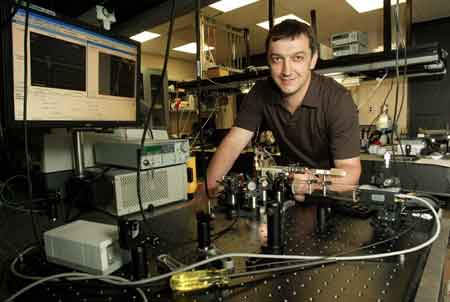A team of Princeton and Rice University researchers has developed a new sensor to measure the concentration of nitric oxide extremely accurately. They believe that a system based on the sensor could find uses ranging from the study and control of car and truck emissions to monitoring human exposure to pollutants in urban and industrial environments.
For medical uses, such a system would be particularly useful because the results would not be corrupted by water vapour, which is present in breath samples. Testing for nitric oxide in a patient's breath, for example, could reveal chronic obstructive pulmonary disease and inflammation.
'The sensor we've developed is much more accurate and sensitive than those in existing systems, yet is far more compact and portable,' said Gerard Wysocki, assistant professor of electrical engineering at Princeton.
Wysocki is the co-leader of the team that developed the system, which also included Rice researchers Frank Tittel and 1996 Nobel laureate Robert Curl, both pioneers in the field of molecular detection using lasers, as well as Rafal Lewicki and James Doty, also of Rice.
With improvements made after an initial test at the Beijing Olympic Games, the researchers claim that the sensor could now be incorporated into a portable, shoe-box-sized system ideally suited for mass deployment in large-scale unattended sensor networks.
Existing systems to detect nitric oxide and other trace gases have a variety of drawbacks. Some, such as carbon monoxide sensors for homes, are compact and inexpensive, but not very sensitive. These sensors can at best detect gases at parts-per-million concentrations, but they cannot detect gases at the parts-per-billion level, let alone the parts-per-trillion level that some applications require.
High-end systems, such as mass spectrometers and gas chromatographs, are much more sensitive, but are slow, bulky, complicated and expensive and impractical for use outside of a laboratory.
Optical systems can offer intermediate sensitivity. These pass a laser beam through a gas sample and detect whether some of the laser light is absorbed by the gas sample. A weakness of this method is that the amount of absorption is very small compared to the overall amount of laser light, so the signal is hard to detect. Further, conventional optical sensors tend to be bulky, use large amounts of the sample and require frequent operator intervention.
The new system developed by Princeton and Rice researchers uses optical sensing as well, but produces a much stronger signal. In their setup, the researchers pass the laser light through polarising filters that block all light unless nitric oxide is present. Roughly speaking, the more nitric oxide, the more light makes it through the filters, Wysocki said.
Nitric oxide detectors have used similar methods before, but until now have been hampered by their reliance on large laser sources designed for laboratory use, he added. The new system, in contrast, uses a quantum cascade laser. This makes it possible to reliably detect the gas at a concentration of a few parts-per-billion. The device is so precise it can distinguish between different isotopes of nitrogen and oxygen in the nitric oxide molecules.
Unlike other systems that need several litres of the sample gas, the compact new sensor needs only a few millilitres of it. This is particularly important in biological applications such as cell-culture studies, said Wysocki. Another important point is that the new system can run much longer without intervention - several hours compared to just a few minutes for even the best existing ones - to allow for long-term unattended operation.
Princeton researchers are working on various enhancements to the technology, further shrinking the size of the device and exploring an even more sensitive method of analysis called coherent detection. 'This technique could help us achieve parts-per-trillion sensitivity,' Wysocki said.

Gerard Wysocki, an electrical engineer at Princeton, worked with colleagues at Rice University to develop a portable and sensitive method for detecting nitric oxide gas. The device uses a laser and an innovative type of polarising filter to detect very small quantities of the gas




Glasgow trial explores AR cues for autonomous road safety
They've ploughed into a few vulnerable road users in the past. Making that less likely will make it spectacularly easy to stop the traffic for...